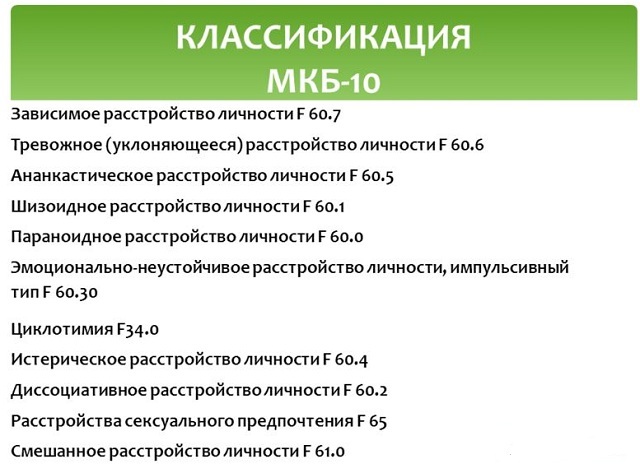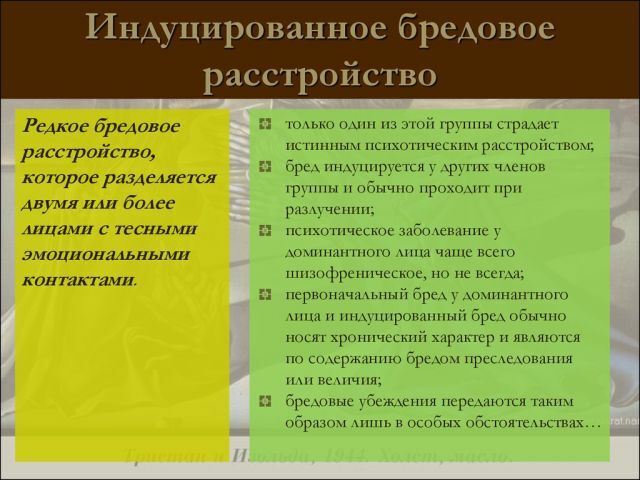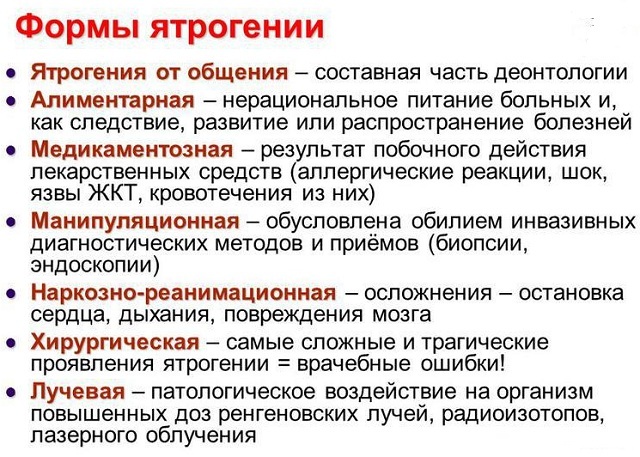 A fairly large percentage of elderly people are prone to such an unpleasant disease as an involuntary presenile psychosis.
A fairly large percentage of elderly people are prone to such an unpleasant disease as an involuntary presenile psychosis.
This is a mental illness characterized by such abnormalities as the persistent presence of depressive states, the appearance of paranoid thoughts, delusions of damage, and hallucinations.
These symptoms can develop both separately and simultaneously. Usually the depth and nature of the symptomatology directly depends on the person's age. For example, among people aged up to 65 years old, suffering from mental illness, about 5% suffer from involuntary psychosis. With an increase in age, senile psychosis occurs more often than 10%.
The disease develops gradually, rather slowly, but in some cases it may appear quite unexpectedly. As a rule, this is accompanied by strong emotional upheavals experienced by an individual, mental trauma or some somatic condition.
Initially, everything can just look like an excessive concern for your health or the health of your loved ones, and experiences develop on a variety of issues. Over time, seemingly insignificant symptoms develop into a full-blown depression, nonsense and paranoid.
More often the disease is observed among women.
Contents
- Differences from senile psychosis
- Factors provocateurs
- Who is at risk
- Complex clinical picture
- Paranoid manifestations and delirium of damage
- Melancholy features
- How can one be suspected from the outside?
- Therapy methods
- Consequences and possible prevention
Differences from senile psychosis
Do not confuse involuntary psychosis with senile. In the first case, the main causes of the disease are mainly internal factors: 
- type of character;
- suspiciousness;
- anxiety;
- severe mental turmoil for various reasons.
Senile same psychosis( or as it is also called - senile) develops completely for other reasons: it may be inactivity, impaired functioning of sensory organs, poor malnutrition, problems with sleep.
In addition, senile psychosis can be quite irregular - at one time, its symptoms are significantly amplified, and in another almost completely disappear. If we talk about involutionary psychosis, then it is characterized by a more even and stable development.
Factors provocateurs
Despite the fact that doctors and specialists distinguish some important factors that are believed to be capable of provoking the development of involutional psychosis, in fact the etiology of this disease is actually unknown.
Usually, doctors can only ascertain the presence of the disease according to its specific symptoms and take medical measures, but to predict the development of violations or prevent it in advance is very, very difficult.
Among the possible provocative reasons are:
- Bad heredity .If someone in the family observed such deviations, then the likelihood that the episode will recur.
- Long-term presence in the severe intense emotional environment of the , including family scandals, a heavy working rhythm, and so on.
- Strong nervous and mental turmoil as a result of any traumatic events. Again, the personality of the individual and his heredity are also very important here. In one person, an event will not cause a special reaction, but for another it can become a trigger for the development of mental illness.
Who is at risk
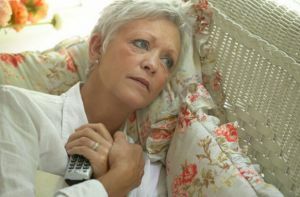 The greatest danger presenile and senile psychoses represent for the elderly, and especially for women. Cases have been documented in people from about 45 years old.
The greatest danger presenile and senile psychoses represent for the elderly, and especially for women. Cases have been documented in people from about 45 years old.
Most often the same set of violations observed at the age of 50-60 years. If in the life of the patient there are constant nervous shocks, stresses and depressive states, and relationships with family and relatives leave much to be desired, then the probability of mental illness increases manifold.
Complex clinical picture of
Presenile psychosis is characterized by such basic signs and symptoms:
- The elderly have hallucinations, illusions and auditory deceptions of .This is manifested by the fact that the patient claims that he hears the whispers of people who are preparing a vile conspiracy against him, noise behind a wall that is not actually observed, the sound of footsteps even in an empty apartment.
- Complaints about non-existent, contrived problems .For example, a patient can claim that his stomach or liver hurts, since his food was poisoned by ill-wishers who are pursuing him. The so-called delusion of damage develops.
- For senile psychoses, the characteristic is a sharp change in the appearance of the .If suddenly an elderly person completely suddenly and quickly decayed, lost a lot of weight, then it most likely indicates serious problems in his mental state.
Also for presenile mental disorders symptoms of Krapelin's disease associated with the presence of an alarming depressive state are characteristic. This is most often expressed in:
- lack of normal sleep, the inability to fall asleep in time;

- incoherent muttering with himself, vaguely said words and sentences that are very difficult or impossible to disassemble;
- externally, an elderly patient may show great confusion, inability to concentrate his attention on certain subjects, people, conversation.
In medicine, it is customary to distinguish three basic forms of pre-mental psychosis:
- an involutional paranoid;
- delirium damage
- involutionary melancholy.
We will discuss in more detail their features and main differences.
Paranoid manifestations and delirium of
damage The involutional paranoid is characterized by the fact that the patient is inclined to various delusional disorders in which he is completely perverted, wrong, and often very aggressively considering his relationships with his own close people, friends, family members, and any acquaintances. The old man may have persistent obsessive delusions that grab his thoughts and prevent him from focusing on the  with something else.
with something else.
Very often patients with involutional paranoid develop a so-called delusion of harm - they think that the people around them, in particular family members, want to cause them some harm, rob, mutilate and similar things. Since the circle of communication of such patients is usually very narrow and confined to the same family, their fears to an outsider can sometimes even seem convincing. In fact, there is a delusion of damage.
Features of melancholy
Involutional melancholia can be divided into two subcategories: malignant( Krepelin's disease) and senile. Symptoms of both of them grow quite slowly, with the passage of a long time.
Of course, any psychological trauma can significantly accelerate their development. The old involutional melancholy is accompanied by a constant sense of anxiety: the patient is depressed, he expresses unreasonable unrest for the health of himself and his loved ones, often he may worry about his material welfare, for some reason believing that he is in trouble.
Very often, the negative attitude of a person increases closer to the dark time of the day. Even the slightest change in the environment, the circle of communication or the house( for example, the apartment was cleaned up) can cause attacks of anxious depression and emotions.
Krepelin's disease( malignant involutional melancholy) is characterized by such an important difference as the presence of constant anxiety arousal.
It is very difficult for the patient to concentrate attention, speak coherently and clearly, normally fall asleep. Melancholia occurs in people after 65 years, when brain neurons significantly reduce their activity. It is during this period that the individual is most susceptible to a variety of mental disorders.
How can I be suspicious?
Many symptoms of mental illness can be detected only by a doctor, in order for a common person, for example a close patient, to understand that his relative has an involuntary psychosis, one must know the characteristic signs of this deviation:
- , whether the prospective patient has delusions of persecution and harm,unreasonable constant anxieties and mistrust of others;
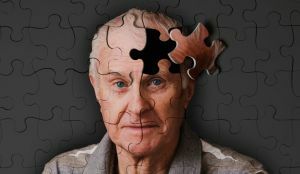
- needs to be assessed whether the patient can speak clearly, adequately, according to the topic of the conversation;
- it is necessary to evaluate whether a person can normally fall asleep, do not disturb him at night with any unsettling thoughts that have no ground.
These manifestations will help to understand that a person develops a mental illness and promptly consult a doctor.
In case of manifestation of suspicious symptoms, it is necessary to consult a doctor for diagnosis. This is the only way to unequivocally confirm or deny your suspicions.
The doctor will examine the patient, ask him a series of leading questions that will help to clearly understand what kind of problem to deal with.
Methods of therapy
One of the main principles of treatment of involutional psychosis is the principle of "do no harm".It is necessary to find such an approach to treatment in order to exclude further aggravation and development of violations, not to give rise to even greater distrust on the part of the patient.
If you do not allow the development of a chronic form of the disease, then it can already be considered in some way a considerable victory in psychosis.
The main role in the treatment process is played by medications. The number of names and dosages is strictly limited, since the  usually has to deal with older people who simply can not tolerate a large number of medications taken.
usually has to deal with older people who simply can not tolerate a large number of medications taken.
Antidepressants Pirazidol, Zoloft, Tianeptine, Ludoimil, Anafranil and many others are actively used. The main requirement for drugs - they must have a minimum of possible side effects.
Neuroleptics with sedative effects are often prescribed. They help to suppress the feeling of anxiety, to remove the excitation of the nervous system, to fall asleep normally.
Soothing is best for people with Krapekin's disease. As for involutional melancholia, here the main role is played by neuroleptics with a psychotic effect. They help to cope with delusions, overcome various hallucinations, including auditory ones.
Separately it is worth mentioning the importance of friendly conversations and sessions of psychotherapy. This measure helps the patient to become more calm, balanced, at least a little out of the anxiety state.
Consequences and Possible Prevention
Over time, people are increasingly losing touch with the real world, living fictitious and far-fetched anxieties, can significantly spoil relations with others and people close to him, becoming a very unpleasant and strong burden for them.
Reason gradually leaves such a person and he ceases to adequately perceive the world around him, which can ultimately result in complete disability.
In case of adequate supportive treatment, in most cases a person will be able to live a normal normal life, but he should always be treated with extreme caution. No quarrels and experiences should concern him. The patient should be enveloped in an exceptionally positive atmosphere and unobtrusive care.
As for the prevention of the disease, it is reduced to attempts to delay the very process of aging the organism and the destruction of the nervous system. 
This is achieved by quite standard methods: correct moderate nutrition, exercise and exercise in a reasonable amount, a constant mental work that helps brain neurons to be active and build new connections, thereby degrading the brain significantly slows down.
It is very important that elderly people are enveloped in the atmosphere of well-being, order and peace. They should not worry, especially for serious reasons, otherwise the oppressed state and stresses will cause mental failures of one kind or another. It is also very important to get enough sleep and observe the regime of the day.
In general, involuntary psychosis is a rather dangerous and unpleasant disease that can be trapped by every elderly person, when symptoms appear, you need to go to the doctor in time and take up the treatment. This in many cases helps to maintain human health and return it to a normal state.

